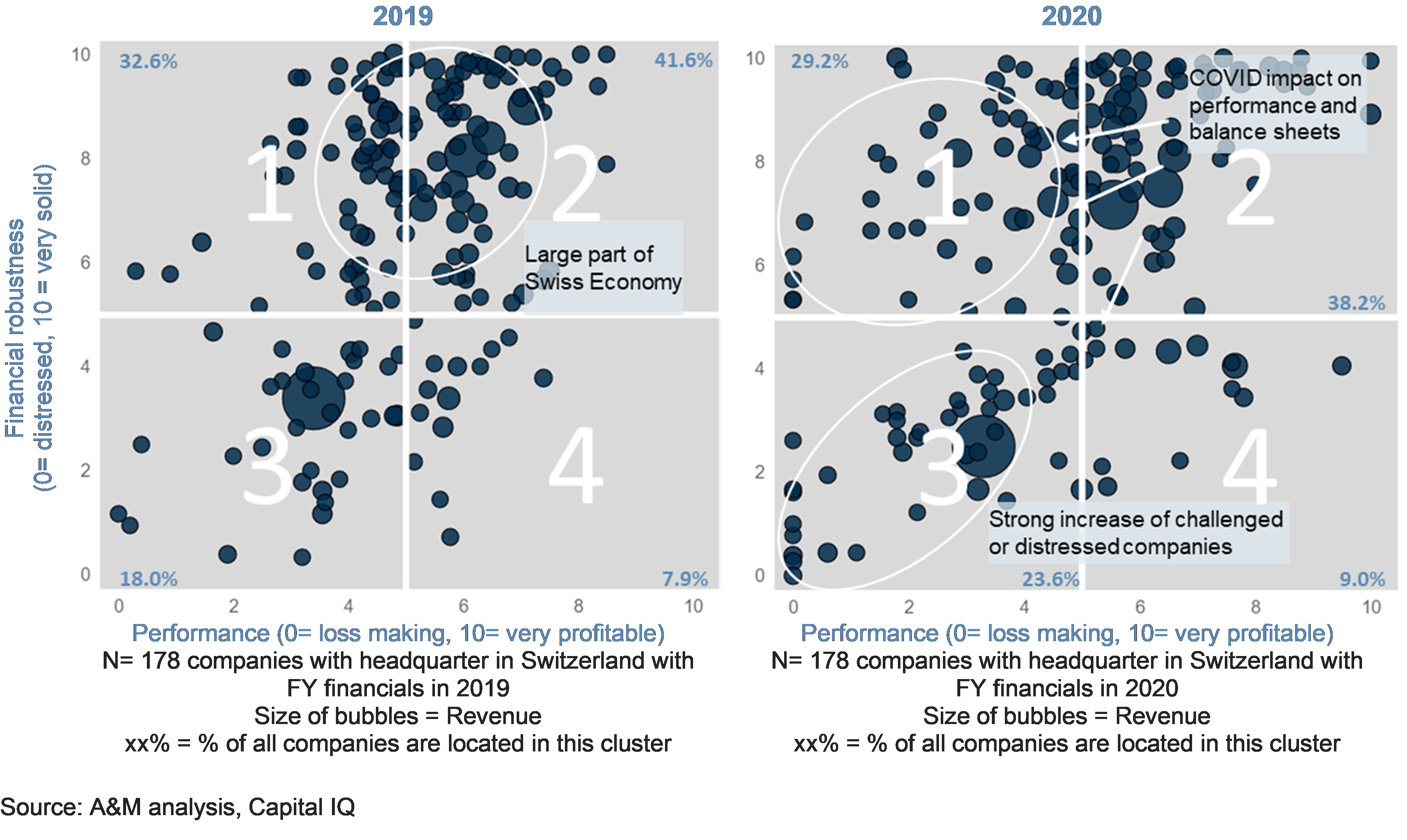Delayed bankruptcies of Swiss companies likely to occur in 2022 and onwards
- In 2020, the proportion of companies in financial difficulties in Switzerland increased by more than 30% compared to 2019.
- Close to 180 companies were analysed in A&M’s latest study on the economic impact of the COVID-19 pandemic in Switzerland.
- About a quarter of Swiss companies analysed suffered from severe financial conditions in 2020.
- As state support measures come to an end in 2022, the risk that delayed bankruptcies in 2020 and 2021 start to materialize in 2022 is high.
Zurich – An analysis by global professional services firm Alvarez & Marsal (A&M) found that many bankruptcies and insolvencies in Switzerland did not occur in 2020 and 2021 due to financial state aid measures of a total value of CHF 42 billion and other supporting measures granted since the beginning of the pandemic. Although 2020 was a year of economic contraction, the number of bankruptcies and insolvencies in Switzerland (as in many other countries) declined by almost 20% compared to 2019. The financial position of Swiss companies has also worsened due to an increase in debt or drop of liquidity and a decline in earnings. With the end of the financial state measures in early 2022, the Swiss economy may face a rise in the number of bankruptcies and insolvencies.
Swiss companies with higher debt and lower profitability in 2020
A&M’s analysis shows a deterioration in the financial performance and position of Swiss companies, due to an increase in debt or deterioration of liquidity and a decline in revenue and profit. The proportion of Swiss companies in such a challenging or (di-)stressed position increased by 5.6 ppt to 24% or by more than 30% compared to 2019 (see figure below). Nearly a quarter of the 178 Swiss companies analysed, which exclude the financial and real estate sector, suffered from severe financial conditions in 2020.

Alessandro Farsaci, Managing Director at A&M Switzerland, commented: “The phenomenon of delayed bankruptcies, which we call the COVID-19 bankruptcy gap, is an increasing concern for the Swiss economy. The state aid measures granted during the pandemic have not sustainably prevented certain bankruptcies but simply delayed them. Decision makers are going to face challenging transformations, turnarounds and restructurings. Companies will also need to adapt their business and operating models to the needs of a post-COVID world.”
Financial state aid currently planned to start phasing out in February 2022
In the initial period of the pandemic, a survey by Statista conducted in Summer 2020 amongst Swiss Board Members revealed that less than 10% of Swiss companies decided to discontinue loss-making businesses or locations. As business leaders expected the pandemic to be shorter and less harmful, there is a high risk of a catch-up in the number of insolvencies in Switzerland with the already ended or starting to phase-out of state aid measures:
- The state-backed COVID-loan program ended on 31 July 2020;
- Hardship support programs started to phase out in certain Swiss cantons and are foreseen to end in December 2021;
- The extended and simplified Swiss short-time work allowance in which 20% to 25% of the Swiss workforce was enrolled at its peak level in April 2020, will expire in February 2022;
- Repayment obligations for COVID-19 loans up to CHF 500k are currently expected to start in early 2022.
Challenges for Swiss companies in 2022 and beyond
The road ahead of the Swiss economic recovery will be subject to the following developments:
- The global slowdown of the post-pandemic economic recovery;
- Despite a low unemployment rate in Switzerland, the fear of increasing unemployment might be sufficient for consumers to increase savings and reduce consumption for non-essentials;
- As demand has picked up, working capital requirements have increased and in turn adds to the pressure on companies’ liquidity position. Those companies which released cash tied-up in working capital during the pandemic will be particularly hit;
- Companies will feel the pressure to adapt business and operating models through restructurings in order to protect future earnings.
- The high commodity prices combined with supply chain disruptions bring further uncertainty for Swiss companies.
- The recent strengthening of the Swiss Franc represents a risk for the economy given the importance of exports.
For all stakeholders and decision-makers facing challenging transformations, turnarounds or restructurings, it is key to understand the businesses’ options, which are fix, sell or close, and carefully evaluate how these options can be implemented, without taking disproportionate economic risks, so called value erosion, for stakeholders or legal risks for companies themselves as well as its Board members and Management.
Notes to editor
Methodology
To illustrate the potential need for restructuring and the financial impact of COVID-19, A&M analysed the development of the financial and earnings position of Swiss companies with more than CHF100 million revenues (excluding financial institutions and real estate companies) in FY 2019 and FY 2020.
A&M analysed and evaluated variables and ratios related to balance sheet (financial robustness) and income statement (earnings position), taking into account the sector affiliation. The evaluation is based on more than ten ratios on a scale from 0 (distressed / loss-making) to 10 (solid / very profitable). The result (Figure 1) is presented in a matrix with four quadrants, where each circle represents a company (size of circle = sales level). The four quadrants can be interpreted as follows:
- Quadrant No. 1: companies have a fundamentally solid balance sheet, but show weaknesses in their earnings or profit situation.
- Quadrant No. 2: includes companies that have a solid balance sheet and robust earnings situation
- Quadrant No. 3: comprises companies that have (significant) deficits in terms of both their financial and earnings situation. These therefore have insufficient liquidity and/or inadequate capital structure and, at the same time, weak/insufficient profitability. Some of these companies are therefore likely to be challenged or "financial (di)stress".
- Quadrant No. 4: shows companies with a robust earnings/profit performance but insufficient liquidity and/or inadequate capital/financing structure.
Full study
If you wish to receive the full study, click here.
Media contact
Cabinet Privé de Conseils, Geneva
Michael Füglister & David Folley
Tel. +41 022 552 46 46
alvarezmarsal@cpc-pr.com




